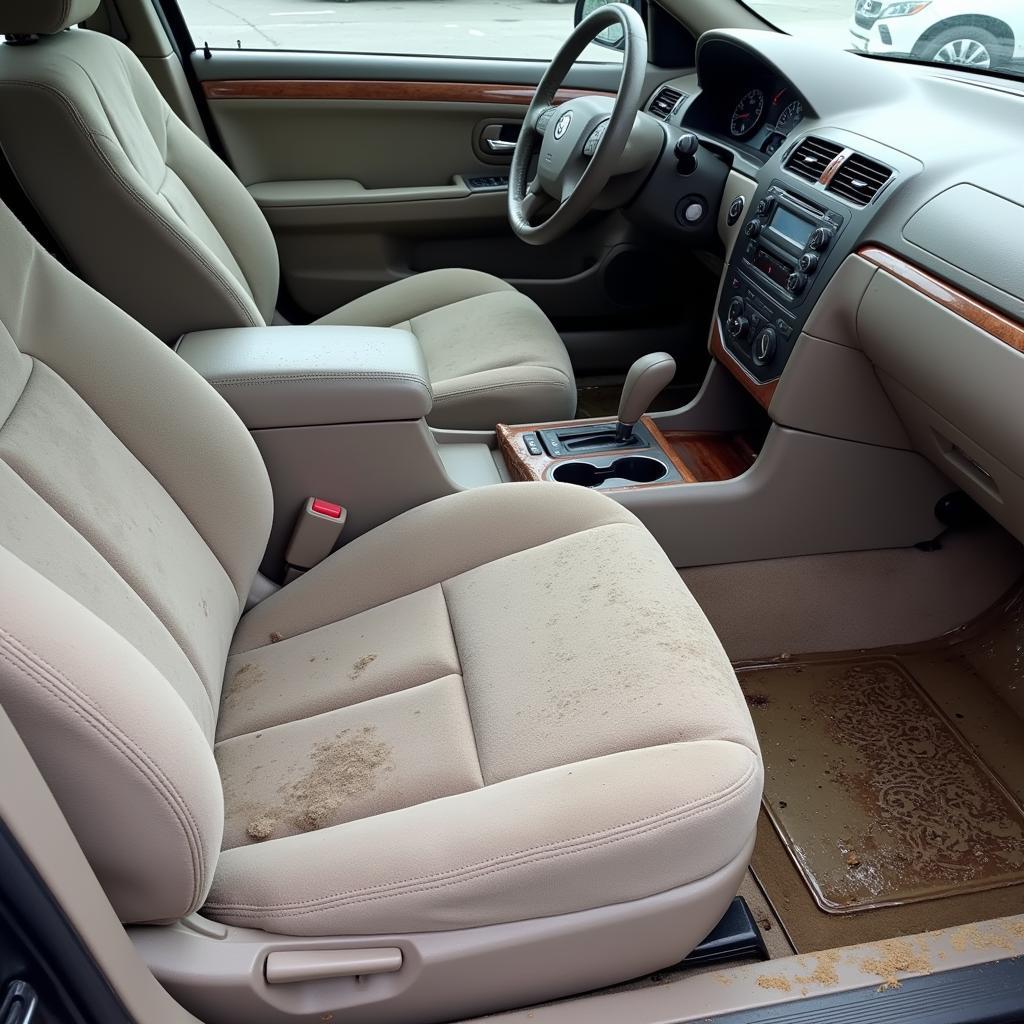A flood-damaged car can seem like a total loss, leaving you wondering, Can A Flood Hit Car Be Repaired? The answer isn’t a simple yes or no. While some flood-damaged vehicles can be salvaged, the decision to repair depends on several crucial factors, including the depth and duration of the flooding, the type of water (fresh or saltwater), and the extent of the damage to critical components.
Understanding the Damage: Flood Water’s Impact on Vehicles
Flood water can wreak havoc on a car, affecting everything from the upholstery and carpets to the engine and electrical systems. Freshwater flooding, while less corrosive than saltwater, can still lead to mold, mildew, and rust. Saltwater, on the other hand, accelerates corrosion and can quickly destroy metal parts, wiring harnesses, and electronic components. The longer a car sits submerged, the more extensive the damage becomes, increasing the likelihood of long-term issues even after repairs.
Mechanical Damage: Assessing the Core Components
The engine and transmission are particularly vulnerable to flood damage. Water entering these systems can cause catastrophic failure. Even if the car starts after being dried out, internal rust and corrosion can lead to premature wear and eventual breakdown. Similarly, the brakes, steering system, and suspension can be severely compromised, posing serious safety risks.
 Flood-Damaged Car Engine
Flood-Damaged Car Engine
Electrical System Woes: The Hidden Dangers
The electrical system is often the hardest hit area in a flood-damaged vehicle. Water can short-circuit sensitive electronic components, including the ECU (Engine Control Unit), sensors, and wiring harnesses. These issues can lead to intermittent problems, malfunctioning systems, and even electrical fires. Modern vehicles are heavily reliant on electronics, so even seemingly minor electrical damage can have far-reaching consequences.
Evaluating the Extent of the Damage: A Comprehensive Approach
Determining the repairability of a flood-damaged car requires a thorough inspection by a qualified mechanic. They will assess the extent of the damage to all systems, including the engine, transmission, electrical system, brakes, steering, suspension, and interior. They will also check for hidden damage, such as corrosion behind panels and inside wiring harnesses.
 Flood-Damaged Car Interior
Flood-Damaged Car Interior
“A thorough inspection is absolutely crucial,” says John Miller, a certified ASE Master Technician with over 20 years of experience. “You need to know exactly what you’re dealing with before deciding whether to repair or replace.”
The Cost Factor: Repair vs. Replacement
Repairing a flood-damaged car can be expensive, especially if there is significant damage to the engine, transmission, or electrical system. In some cases, the cost of repairs may exceed the value of the vehicle, making it more economical to replace the car altogether. Insurance companies typically declare a flood-damaged vehicle a total loss if the repair costs exceed a certain percentage of the car’s pre-flood value.
Making an Informed Decision: Weighing the Risks and Rewards
Deciding whether to repair a flood-damaged car is a complex decision that requires careful consideration. You need to weigh the cost of repairs against the value of the vehicle and the potential for long-term problems. Even with extensive repairs, there is always a risk of lingering issues, such as electrical glitches, corrosion, and mold.
 Flood-Damaged Car Inspection
Flood-Damaged Car Inspection
“Remember, a flood car is always a gamble,” advises Sarah Johnson, an automotive consultant specializing in vehicle appraisals. “Even if it seems drivable after repairs, hidden problems can surface later down the line.”
Conclusion: Proceed with Caution
Can a flood hit car be repaired? Yes, sometimes. However, the decision requires a comprehensive inspection, careful consideration of the repair costs, and an understanding of the potential long-term risks. Often, replacing the vehicle is the safer and more economical option in the long run. If you’re considering buying a used car, always check its history for flood damage to avoid potential headaches down the road.
FAQ
- Can a flooded car be repaired if it was submerged in saltwater? Saltwater damage is more severe than freshwater damage, making repairs more complex and costly. It’s often not worth repairing a saltwater-flooded car.
- How can I tell if a used car has been flooded? Look for signs of water damage, such as rust, mildew, and a musty odor. Check the vehicle’s history report for flood damage records.
- Does insurance cover flood damage? Comprehensive insurance typically covers flood damage, but not liability insurance.
- What are the long-term effects of flood damage on a car? Corrosion, electrical problems, and mold are common long-term issues in flood-damaged cars.
- Is it safe to drive a flood-damaged car after it’s been repaired? Even after repairs, there’s a risk of lingering issues. A thorough inspection by a qualified mechanic is essential.
- How much does it cost to repair a flood-damaged car? The cost varies depending on the extent of the damage. It can range from a few hundred dollars to thousands of dollars.
- Should I buy a flood-damaged car? It’s generally best to avoid buying a flood-damaged car due to the potential for long-term problems.
Need more assistance? Check out our other helpful articles on car maintenance and repair on our website. For personalized advice and support, contact our 24/7 customer service team via WhatsApp: +1(641)206-8880 or Email: [email protected].


